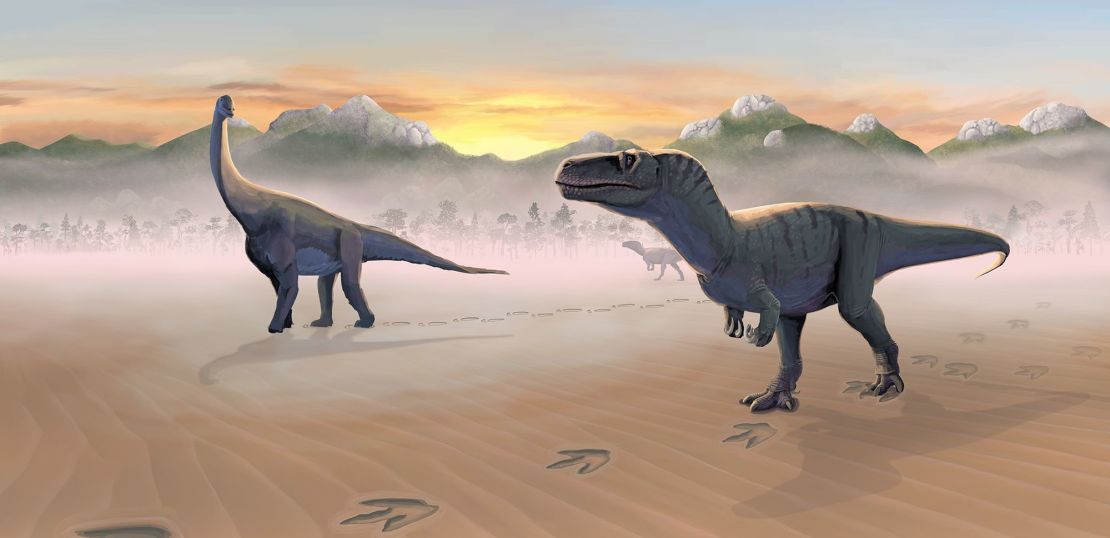Publisher’s note: A version of this story appeared in the Wonder Theory Science newsletter of CNN. To get it in your reception box, Register for free here.
Cnn
–
Imagine the Sahara, and an inhospitable landscape of endless sand dunes and sterile rock comes to my mind.
This is largely the case today, but 7,000 years ago, the vast desert was a completely different place: a green world of trees and rivers and which houses megafauna like hippopotams and elephants.
In recent decades, scientists have gleaned the details of the “green Sahara”. Now, with the help of ancient DNA of mummified remains, geneticists determined who used to live there.

The Takarkori Rock refuge – located in the Tadrart Acacus mountains of Libya Tadrart – offers a remarkable overview of the Green Past of the Sahara.
Archaeologists discovered the remains of 15 women and children on the site two decades ago.
The first attempts to extract ancient DNA from the remains flat. Fresh and constant conditions – the opposite of today’s extreme temperature oscillations – give the best preserved DNA.
New techniques have made it possible to sequence the genome – a complete set of genetic equipment – two mummified women. The analysis revealed intriguing information on the ancestry of the Takarkori people and how they adopted a livestock lifestyle.
Black energy is a mysterious force that accelerates the expansion of the universe, and we think that it represents around 70% of the energy of the cosmos.
New clues of the collaboration of black energy spectroscopic instruments, known as desi, suggest that dark energy can behave unexpectedly and can even weaken over time.
The collaboration, now in its fourth year of surveying of the sky, has published its latest batch of data. Although this is not the last word, information excites space scientists.
“We are letting the universe tell us how it works, and perhaps the universe tells us that it is more complicated than we thought,” said Andrei Cuceu, a postdoctoral researcher at Lawrence Berkeley National Laboratory, who manages Desi.

A SpaceX Falcon 9 rocket sent four tourists to a crew dragon capsule on a polar orbit never attempted before.
The Lance of the Mission Fram2 was the resident of Malta, Chun Wang, who made the fortunes of Bitcoin’s extraction operations. He paid in SpaceX a sum not disclosed for this trip.
Watch a video of the spatial ship splash Friday, off the California coast, after Wang and her teammates – director Jannicke Mikkelsen, robotic researcher Rabea Rogge and adventurer Eric Philips – spent 3.5 days in low orbit.
It was the first trip to space for each of the four crew members, who all have links with the exploration of polar land.
Meanwhile, Suni Williams of NASA and Butch Wilmore spoke this week for the first time following a prolonged mission of nine months in space. Here’s what they had to say.
For the unused eye, stone tools can look like ordinary rocks, but for specialists, they have fascinating stories to tell.
The researchers found stone artifacts made in a style closely associated with the Neanderthals in East Asia for the first time on a site in the southwest of the province of Yunnan in China.
The discovery, dating from 60,000 to 50,000 years, perplexed archaeologists, who found competing assumptions to explain the tools in stone.
Perhaps the Neanderthals could have migrated to the east and reach what is now China, or a different species of ancient human possibly manufactured tools strangely similar to those discovered in Europe.
Anyway, the answer could shake what we know from human origins to the Stone Age.

The ancestors of T. Rex and their prey eaters of plants would have gathered to drink water in a lagoon on what is now the island of Scotland of Skye, according to an analysis of newly identified fingerprints.
The author of the main study, Tone, Blakesley, said that he was part of a small group that recognized three first footprints on the distant site of the island’s Trottenal Peninsula in 2019 when he was a graduate student at the University of Edinburgh.
“It was very exciting,” said Blakesley. Documenting a total of 131 footprints, he used a drone to take thousands of images overlapping the site before producing digital 3D models of the slopes. They are kept in “exquisite details,” he added.
Immerse yourself in these remarkable stories.
– The discovery of the tomb of a mystery king in Abydos, Egypt, reveals new clues to a dynasty has long been notoriously lacking in the archives of Pharaohs which have once ruled the region.
– Scientists sent a container of soy paste baked to the international space station, where it was left to ferment before returning to Earth as Miso. Here’s how it tasted.
– A strange spiral recently lit a European sky, and it becomes a more common spectacle.
– Archaeologists excavating a massive grave in Pompeii discovered extremely rare marble statues, almost magnitude on the power held by the priestesses of the ancient city.
Do you like what you read? Oh, but there is more. Register here To receive the next edition of Wonder Theory in your reception box, provided by CNN Space and Science Writers Ashley Strickland,, Katie Hunt And Jackie Wattles. They find wonder in the planets beyond our solar system and the discoveries of the ancient world.


